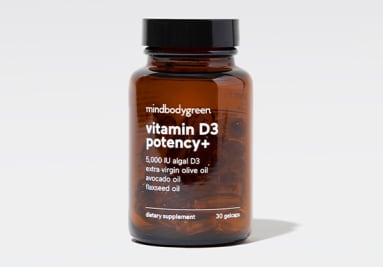Why You Should Avoid Yo-Yoing Vitamin D Levels (And How)
There is something you can do about it, though.

Image by Javier Díez / Stocksy April 5, 2023 Vitamin D insufficiency and deficiency are rampant in this country. (In fact, almost half the population1 of the U.S. is insufficient and almost one-third are deficient2.) But an overlooked part of the vitamin D conversation is what scientific affairs Ashley Jordan Ferira, Ph.D., RDN, calls the yo-yo phenomenon. Sounds harmless (and maybe even a little fun), but, alas, it's not as cute as the moniker may have you believe. Still, the yo-yo, which refers to fluctuating vitamin D levels (in and out of a sufficient state), is quite common. Here's what you should know about why it's a problem.
Advertisement
This ad is displayed using third party content and we do not control its accessibility features.
What are "yo-yo-ing" vitamin D levels?
Picture this: You test your vitamin D levels at the doctor and receive a serum 25(OH)D lab result (the biomarker for your vitamin D status) of less than 30 ng/ml, which means you're clinically insufficient. As a result, your doctor may recommend you take a D3 supplement daily (and the dose may be variable from one health care provider to another) or may prescribe 50,000 IU of vitamin D2 per week for eight to 12 weeks or so to bump you back up to the sufficient range.* Then, you get tested again, and—hooray!—your levels have zoomed above 30 ng/ml (or maybe you are just slightly above 30 ng/ml now). Your doctor sends you on your merry way, perhaps with no follow-up instructions, and you're all set...right?
Not so fast: "This is a widespread scenario and a surefire equation for yo-yo-ing into vitamin D insufficiency or deficiency in a matter of weeks," notes Ferira. Without a daily maintenance regimen, it's oh-so-easy to dip back into insufficiency—and then the whole process starts anew, like a yo-yo flinging up and down, up and down.
How common is it?
Sorry to say, this on-again-off-again approach to vitamin D is incredibly common. "I have heard about and witnessed this common pattern of temporary sufficiency or yo-yo-ing between vitamin D sufficiency and insufficiency (or deficiency, even) through the years from clients, family, friends, and strangers," Ferira explains. "It's why snapshots in time demonstrate that large proportions22—many millions of Americans—are clinically vitamin D deficient or insufficient."
In other words: Part of the reason we have yet to tackle our widespread vitamin D problem in this country is that we aren't approaching the issue with the goal of maintaining daily vitamin D status for life; only addressing acute results in a reactive manner for a short period of time. Repeat after Ferira: Vitamin D is an essential fat-soluble micronutrient, and it requires daily maintenance.
Advertisement
This ad is displayed using third party content and we do not control its accessibility features.
Why consistently sufficient vitamin D levels are important.
If you yo-yo in and out of suboptimal vitamin D status (or even swing into deficient states), you may never reach truly sufficient levels throughout your lifespan—which, in turn, has broad health implications for your bones, muscles, immunity, neurological function, cardiometabolic health, and more.*
Take it from Ferira: "Vitamin D sufficiency doesn't just mean you're meeting a 25(OH)D level or cutoff," she says. "It means your bones, muscles, immune cells, brain, heart, liver, gut, reproductive organs, and many more cells, tissues, and organs have this critical nutrient available in adequate quantities to bind to vitamin D receptors and promote calcium and phosphorus balance, bone mineralization, muscle strength, immune function, cardiometabolic health, and more."*
And to achieve consistently sufficient levels, again, requires daily maintenance—and daily supplementation is the best evidence-based way to ensure you have enough vitamin D every single day.* Food and sunshine don't exactly cut it (here's why), and prominent D experts and the latest research suggest 5,000 I.U. of D3 per day, which helps you hit an optimal 50 ng/ml level (and keep it there), is a truly effective dose.*
This is exactly why we created vitamin D3 potency+, which offers 5,000 I.U. of vitamin D3 per gelcap (sourced from sustainable organic algae) and features a built-in trio of organic, virgin oils from avocado, flaxseed, and olives (so you can take it with or without a meal).* Because, yes, healthy vitamin D status requires daily maintenance—but that doesn't mean it has to be some giant undertaking.
Advertisement
This ad is displayed using third party content and we do not control its accessibility features.
The takeaway.
Yo-yo-ing vitamin D levels are a very common issue, but when you keep dipping in and out of sufficiency, your vitamin D status and health pay the price. A daily supplementation ritual can propel you out of the yo-yo cycle and is important for maintaining healthy vitamin D levels for life.* (Want more supplement options? Check out our list of top vitamin D picks here.)
If you are pregnant, breastfeeding, or taking medications, consult with your doctor before starting a supplement routine. It is always optimal to consult with a health care provider when considering what supplements are right for you.

 FrankLin
FrankLin 
































